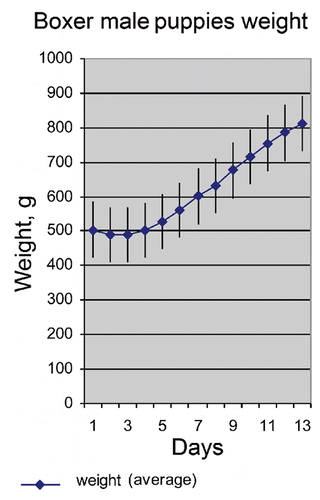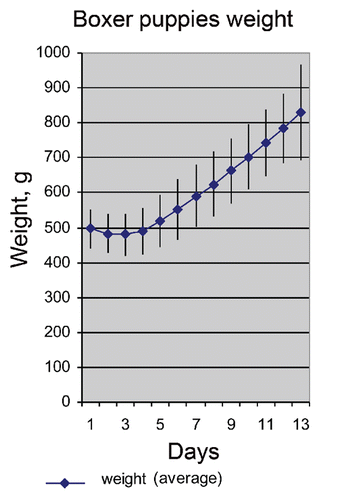Abstract
In the first days after birth is common to observe weight loss in puppies that should not exceed 10% of body weight at birth. The main causes of weight loss are urine and meconium issued followed by non-recovery of fluids expelled. The present study aimed to check and outline growth curves in boxer breed during the first two week of life. In our study, between the 3th and 5th day after birth, puppies have retrieved the weight and doubled their live weight in two weeks. We observed a mean weight loss of 11.26±2.3 g (2.27%) between the first two days of life. Subsequently they recovered the birth weight at day four and puppies with higher weight at birth regained earlier the birth condition and they still were the heaviest at day 13.
KeyWords:
Introduction
In healthy subjects the weight loss at birth is a physiological event related to meconium and urine issue, however it should be less than 4-5%. The weight recovery is usually fast (3-5 days). In some cases the weight loss may reach 10% and represents a negative prognostic indicator for puppy survival (Hoskins, Citation1999). Excessive loss or inadequate weight gain can be due to low bitch milk production, milk low quality or insufficient intake. The study aimed to check and outline growth curves in boxer breed during the first two weeks of life.
Materials and methods
In our study we selected weight values of 350 healthy full-term puppies relative to 75 parturitions from Boxer breed bitches, belonged to the same breeding farm. We considered as full-term a gestation between 62 and 65 days of length and we defined breastfeeding (i.e., exclusively breastfed) as fed only by mother milk, no other food or liquids were added. The pregnant bitches were fed under standard conditions with dry maintenance feed at a dose equal to an increase of 50% of the normal daily requirement. All bitches received an oral integration with folic acid ( Folina®, Marvecspharma Services Srl, Milano, Italy) 5 mg/die since mating to day 28 day of pregnancy. The diet was gradually replaced from day 40 of pregnancy with puppies feed until weaning. No pharmacological treatments were used to promote milk production. After each delivery 0.5 U/kg of oxytocin (Neurofisin®, Fatro Spa, Ozzano nell’Emilia, BO, Italy) was administered intramuscularly to speed up uterine involution. Puppies that died during the first two weeks were not included in the study. The puppies were weighted immediately after birth and four times a day for the following 14 days using a baby scales (Seca 757®, SAMED, Cagliari, Italy). The mean weights were compared and statistically analysed, by ANOVA, Pearson’s correlation, and the level of P<0.05 was set for statistical significance. The study was carried out in accordance with the Italian Legislation on animal care, Law Decree no. 116/92.
Results and discussion
The bitches in our sample completed 75 pregnancies with an average of 4.7±1.8 weaned pups. Males were 164 (46.9%) and females 186 (53.1%). The average body weight at birth was 496.2±55.6 g with a nearly doubling within 13 days (850.2±162.9 g); the mean weight at birth was 503.8±53.2 g in males and 489.4±56.8 g (P<0.05) for female weights. After 3 days of life mean weight loss was 11.3±2.3 g (2.3%), on fourth day the growth curve was reversed with total recovery of birth weight. The growing was linear during monitoring time (, , and ). The study showed a correlation (r=0.92, P<0.05) between weight at birth and the weight on the second day of life; this correlation indicates that larger puppies had a minor weight loss. Even the growth curves of percentiles kept parallel to the curve of average weight. During the first days after birth, weight loss in puppies is considered a physiological event if does not exceed 10%. The main causes of weight loss are represented by the issue of urine and meconium followed by the lack in restoring of expelled fluids. Normally, after the first 3-5 days puppies retrieve birth weight and get gain that will lead to double in about two weeks with differences depending on the breed size (Dobenecker et al., Citation2013; Furniss, Citation2008). In human neonatology the average time to begin regaining weight is around day 4, and the weight loss is totally recovered around day nine. However, there is some evidence that infants born from mothers who received IV fluids during parturition had a greater weight loss, probably due to an excessive neonatal diuresis (Noel-Weiss, Citation2008).
It was reported by Dobenecker et al. (Citation2013), especially in large and giant breeds, that the optimal but not maximal growth is one of the most important targets in regard to healthy development of the skeleton. Literature on this topic pointed out that an excessive energy intake in combination with a balanced diet led to a detrimental impact on the skeleton in breeds predisposed to growing diseases (Meyer and Zentek, Citation1992). Particularly breed specific variations in puppies growth patterns are related to differences in secretion of circulating growth hormone (Furniss, Citation2008). Within four months of life poor nutrition clearly have a direct consequence on future development and during this period alimentary overload and/or deficiencies could be dangerous for the future of the puppies (Corbee et al., 2013; Furniss, Citation2008). Moreover it is well established that low birth weight directly correlates with the extent of neonatal diseases or death (Hoskins, Citation1999). In healthy puppies weight loss should not exceed 5%, and in any case no more than 10%, because of negative prognosis for pups survival at weaning. A study reported weight curves for German shepherd puppies and they were similar to that obtained for Boxer puppies in our study. Especially for rapidly increase of body weight from the 10th days of life (Corbee et al., Citation2012). However, Corbee et al. (Citation2012) did not describe the weight loss nearly the birth since data weights were recorded only at days 0, 14, 28, 56. Nevertheless our study showed this relevant characteristic because puppies were checked four time a day allowing an accurate initial growth curves for Boxer breed.

Conclusions
The loss of body weight in the first days after birth is a physiological event if it does not exceed the amount of urine and meconium expelled. In our opinion the assessment of this parameter can allow to diagnose early stages of suffering or growth delay of the newborn puppy that sometimes can become life-threatening conditions. The authors underline that a daily check of puppy body weight is a good indicator for health status of the newborn; furthermore, this work provides a useful standard to breeders for the assessment of changes in live weight of newborn purebred boxer’s puppies. Moreover data of our study suggest interesting elements, that need further investigations especially related on breed differences in early curves growth and on future survival.
Acknowledgments
The data given in this article were partially presented at the 10th Int. Congr. SIRA, Tirana, Albania, 2012.
The authors would like to acknowledge Dr. A. Tardini, Ducato di Parma breeding farm, and the Italy Boxer Club Busto Arsizio (VA), Italy.
References
- CorbeeR.J. TryfonidouM.A. BeckersI.P. HazewinkelH.A.W. 2012. Composition and use of puppy milk replacers in German Sheperd puppies in the Netherlands. J. Anim. Physiol Anim. 96: 395-402.
- DobeneckerB. EndresV. KienzleE. 2013. Energy requirements of puppies of two different breeds for ideal growth from weaning to 28 weeks of age. J. Anim. Physiol. Anim. Nutr. 97:190-196.
- FurnissG. 2008. The influence of nutrition on puppy and kitten growth and development. Irish Vet. J. 61:191-194.
- HoskinsJ.D. 1999. The veterinary clinics of North America-small animal practice pediatrics: puppies and kittens. Vet. Clin. N. Am.-Small 29:854-855.
- MeyerH. ZentekJ. 1992. Über den Einfluß einer unterschiedlichen Energieversorgung wachsender Doggen auf Körpermasse und Skelettentwicklung. 1. Mitteilung: Körpermasseentwicklung und Energiebedarf. J. Vet. Med. A 39:130-141.
- Noel-WeissJ. CourantG. Kirsten WoodendA. 2008. Physiological weight loss in the breastfed neonate: a systematic review. Open Med 2:99-110.

